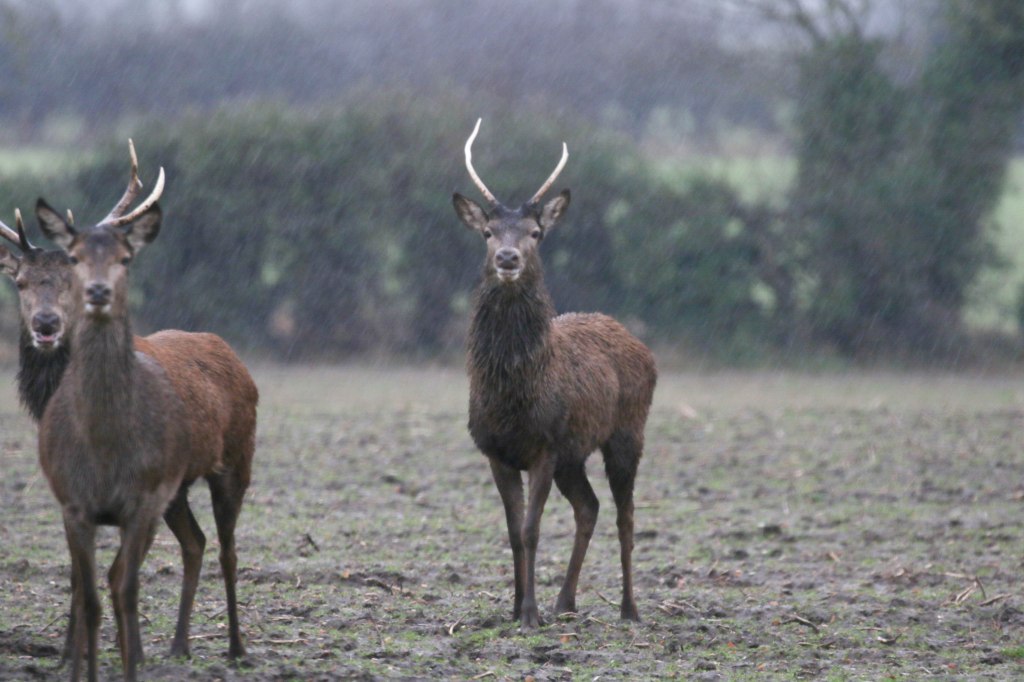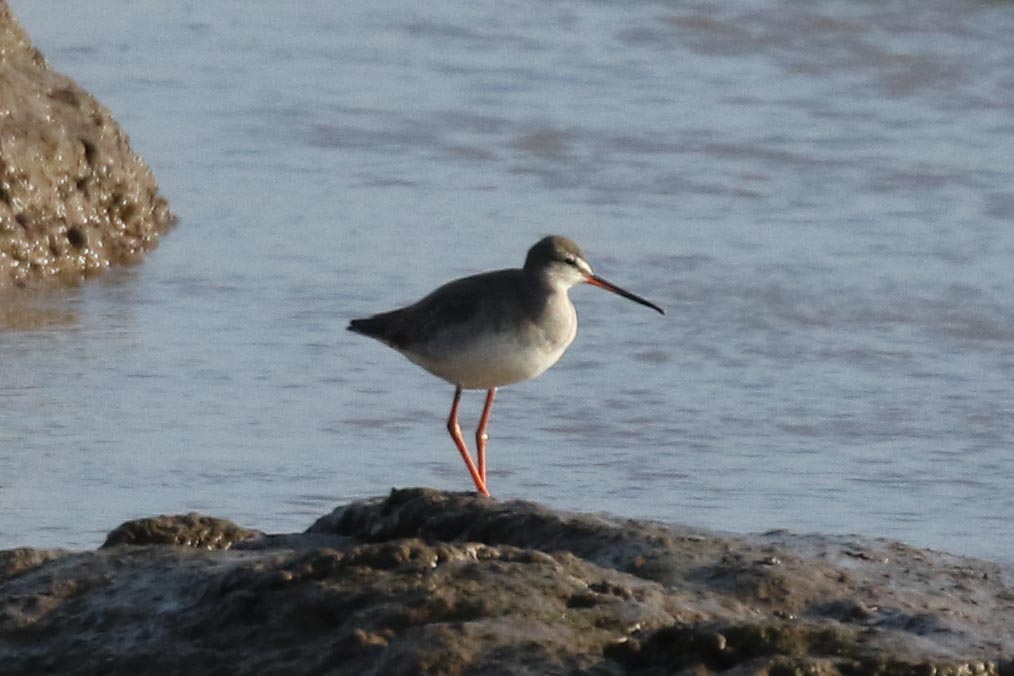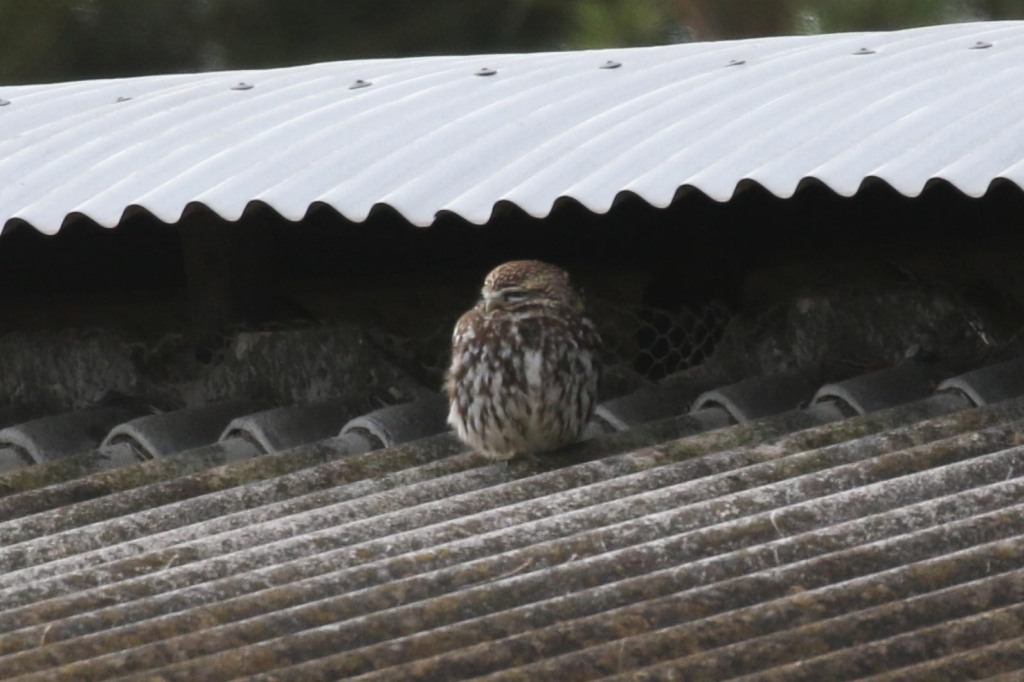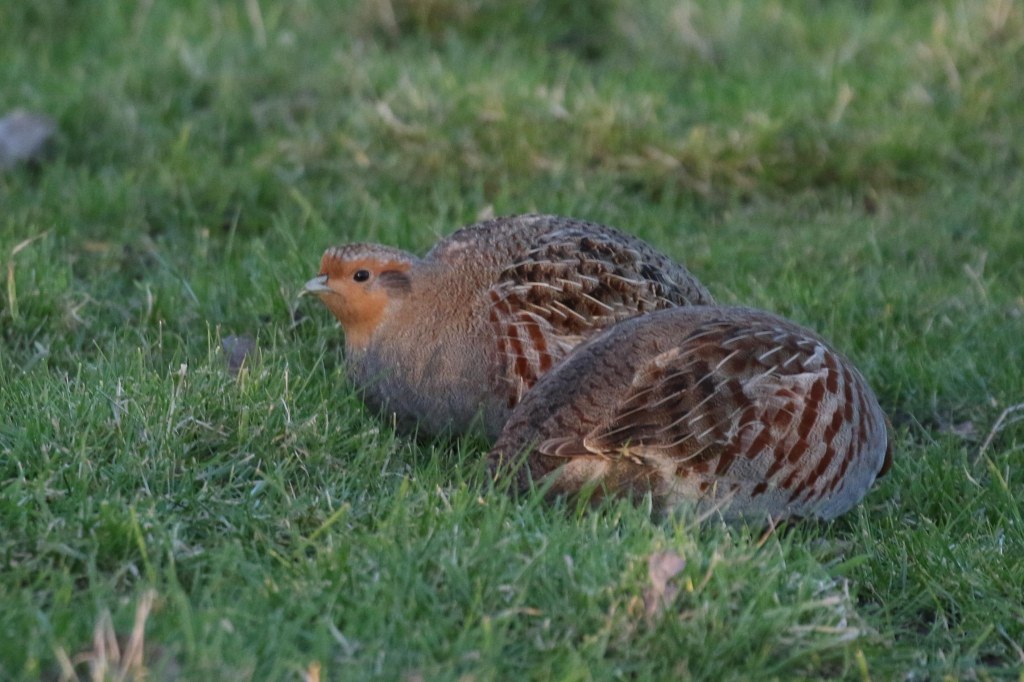Day 1 of a three day Winter Tour today. It was sleeting first thing, but thankfully cleared through earlier than the more pessimistic forecasts and was then dry and sunny, if chilly in a rather blustery W/NW wind. With the appearance of a Red-breasted Goose in North Norfolk yesterday, we spent the day today here along the coast.
Our destination for the morning was Titchwell, where we would be able to get out of the rain in the hides if need be. The drive over produced a few mammals of note. Not long after setting off, we stopped to admire a small group of Red Deer stags in a field. Then, dropping down to the coast from Docking, three Fallow Deer ran across the road in front of us.

As we got out of the minibus in the Titchwell car park, it was still raining. A tit flock was working its way through the trees opposite, including several Long-tailed Tits and a couple of Goldcrests. We had a quick look in the overflow car park, where a couple of Bullfinches flew across as we walked round the corner.
Walking out past the Visitor Centre, we scanned the ditches either side of the path. A Water Rail was in the ditch in its usual place but it was unusually nervous today. It darted underneath a tree stump, so we stopped and waited for it to come out again. It reappeared very quickly but ran up out of the water and disappeared into the vegetation round a pool further back in the trees.
Once we got out of the trees, it was exposed to the wind, rain and sleet, so we pressed on towards Island Hide. A quick look at the reedbed pool produced a few Common Pochard and Coot, and several Common Snipe flew back and forth over the path, pushed up off the saltmarsh by the very high tide this morning. We could hear the big flock of Greylag Geese as they flew in over Thornham grazing marsh honking noisily. An even bigger flock of Pink-footed Geese way off to the west over Holme were out of earshot.
From the shelter of Island Hide, there looked to be surprisingly few birds on first glance, but the more we looked, the more we found. On the muddy island over in front of Parrinder, we could see a Grey Plover feeding next to an Oystercatcher. A small flock of Dunlin scuttling around, flew up and over the bank. There were several Black-tailed Godwits feeding in the water nearby and a couple of Avocets flew up from behind the new bund and landed in the water closer to us.
Scanning the islands further back, we could see lots of Skylarks feeding on the cut grass, along with a few Linnets and a single Meadow Pipit. There were more waders on here too, more Dunlin, a few Turnstone, a couple of Ringed Plover and a lone Curlew. Another Water Rail squealed from the reeds away to our right.
The rain seemed to stopping now and we could see brighter skies to the west already. A Common Buzzard was out on the mud at the back of the Freshmarsh balanced on a clod drying its wings. Several Marsh Harriers came up out of the reedbed and flew round in the wind. Two in succession made low passes over the newly mown Avocet Island, flushing everything.
We picked up a Spotted Redshank hiding over in the far corner. It flew out but landed behind Avocet Island, out of view, from where it was promptly flushed by one of the passing Marsh Harriers. We eventually found it again, in a channel between the island, preening. We had a good look at it through the scopes, in silvery-grey non-breeding plumage. More Avocets appeared now, presumably flushed from the back by the harriers, and spent a few minutes feeding up to their bellies in the deeper water before flying back.
With the weather improving, we headed back out onto the main path. A Reed Bunting flew up into the bushes from beside the path. Some Brent Geese flew in from the saltmarsh and dropped down around one of the islands.

With the big tide, the Volunteer Marsh was completely flooded still, although the water was starting to flow out rapidly now. Several Redshanks flew round trying to find somewhere to drop in and feed.
The Tidal Pools were full of water as well. But that was no deterrent to a smart pair of Red-breasted Mergansers, swimming out on the water.

The sun was coming out now and it was lovely light out on the beach. The waders were really catching the light, looking very smart. There was a good selection, despite the fact that the water hadn’t yet revealed the mussel beds. Lots of Bar-tailed Godwits were feeding around on the shore, with several silvery grey Sanderling running in and out. Two or three Knot dropped in too, before flying on further up towards Thornham Point where we could see even more waders on the sand.
Turning our attention to the sea, a pair of Goldeneye were asleep offshore. Through the scopes, their golden eyes were glowing in the sunshine. A single dark Common Scoter, a young drake, was diving further out and a Great Crested Grebe flew past.
As we walked back, the tide had now gone out on the Volunteer Marsh and there were lots of waders feeding on the freshly revelead wet mud in the channel. Several smart Grey Plovers, a nice close Ringed Plover, and lots of Curlew and Common Redshank.
One bird a little further back looked a bit paler. It walked down into the bottom of the channel and started walking quickly through the water, sweeping its bill from side to side. It was the Spotted Redshank. It came out of the water and up onto the top of one of the muddy islands, where we had a great view in the scopes – we could see its prominent white brow in front of the eye and longer, needle-fine bill.

Back at the Freshmarsh, we stopped for another scan. There were a few more ducks in now and we quickly picked up several Pintail asleep on the new bund. We could see the drakes’ long, pin-shaped tail feathers. All the ducks were looking especially smart in the low winter sunshine, so we turned the scope on them in succession for a closer look at the finer details of their plumage – Teal and Shoveler.

There were several Tufted Duck on the reedbed pool now, as we passed. Someone coming the other way asked if we had seen the Bittern – they had been told by someone in the Visitor Centre that it had been seen along one of the channels. We had a quick look, but there was no sign and we found out later it was actually seen there yesterday! As we turned to leave, a Water Pipit flew up briefly over the reeds, and dropped down out of view on the new pool.
There was still no further sign of the Water Rails, so we made our way back to the picnic area for lunch. There were loads of Goldfinches and Chaffinches in the tops of the trees. A Common Chiffchaff flitted out of the sallows and flicked around briefly in a small bush in the picnic area.
After lunch, we headed back east. The Red-breasted Goose had reappeared as the rain had eased, and we were keen to see if we could find it. We diverted inland to avoid a traffic jam on the coast and were rewarded with a Little Owl on some farm buildings as we passed. We turned round and managed to have a good look from the minibus without disturbing it.

The Red-breasted Goose was right out over the far side of Blakeney Freshes, so we parked in Wiveton and walked out along the Freshes bank. We could hear lots of Pink-footed Geese calling and further up, we found a large flock loafing in the grass in the field nearest the path. We had a good view in the scopes, even if it was hard to see their pink feet in the long vegetation!

We could see a small crowd on the far side as we walked out. When we finally got to them, they were watching the Red-breasted Goose in with some Brent Geese. It was hard to see at times – with its head down feeding, you couldn’t see its red breast and face patch, but we all had a good view through the scopes when it stopped and lifted its head.
A rare visitor here, Red-breasted Geese breed up on the arctic tundra in northern Russia and winter around the Black Sea. Occasionally, birds mix with the Brent Geese and get brought here with them for the winter. Very pretty birds, and always a real treat to see.

Our timing was lucky. After we had been watching the Red-breasted Goose for 10-15 minutes, something spooked the Pink-footed Geese, and they started to take off, the sky echoing to their yelping calls. They took the Brents up with them. The Pinkfeet landed again in one of the fields by the path back towards Cley Mill, but most of the Brents circled round and landed out of view. There was no further sign of the Red-breasted Goose from where we were.
That was a good cue to head back. As we got back to the Mill, a Barn Owl flew past over the reeds and dropped down out of view behind the base of Cley West Bank. After a few wet and windy nights, it was probably getting hungry. It came up again and did a quick circuit of the reeds in front of us before heading out across the Freshes.

The sun was already starting to sink in the sky, so we made a quick dash back along the coast to Holkham. From Lady Ann’s Drive, we scanned the grazing marshes. Close to the fence, we quickly found lots of Common Snipe feeding in the grass, with a Fieldfare in front of them. There were several Curlew, Oystercatcher and further back, a few Ruff too.
A bit further up, two Grey Partridge were pretending to be molehills, feeding just beyond the fence. We stopped to admire them, great to see them so close. A big Mistle Thrush was standing on the grass behind. A Grey Wagtail flew in and dropped down under the big holm oak, where it started feeding around a muddy puddle.

As we walked out along the boardwalk, we met some people coming back who said they had seen nothing out at the cordon. There had been a report of some Snow Buntings from the edge of the Gap, so we thought we would try straight out today, but the path across the saltmarsh was still very wet and very muddy after the earlier big tide.
We tried walking round the edge of the saltmarsh to west, but we couldn’t find a dry way across. With the light going, it would be too far to walk all the way round via the dunes. Unfortunately, after the long walk out at Blakeney, we had just run out of time so we decided to head back. We turned and watched several large flocks of Cormorants streaming in off the beach, heading in over the pines to roost.
We figured we still had time for one quick last stop. In the last of the light, we picked up just a couple of geese still out on the grazing marsh, and through the scope we confirmed they were two White-fronted Geese. We could see the white surrounds to their bills and their black belly bars. A couple of Great White Egrets were still out on the grazing marsh too, one next to a Grey Heron which looked slightly smaller by comparison.
The Great White Egrets flew up into the trees behind to roost. Looking at the trees, we could see all the Cormorants roosting and the branches between were packed with Jackdaws too, an amazing sight. Two more Barn Owls were out hunting over the grass and a Sparrowhawk flew over our heads and out over the marshes.
It was getting dark now – time to head for home. Another two action-packed days ahead of us.
















